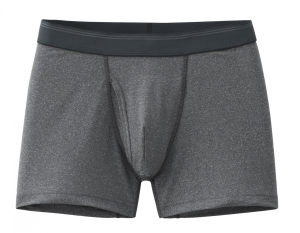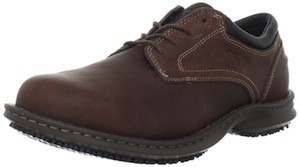
You know all those people who say travel isn’t really so expensive? It’s only kinda true. Sure, you can save big by staying in cheap hostels and shopping in street markets for picnic food, but it’s still going to cost thousands of dollars to fly to France and wander around for a few months. For most people, that’s quite a big deal.
Another issue is the money you might spend before you even arrive, stocking up on flights, rail passes, insurance, and gear. And as much as I love high-tech travel gear, there’s no getting around the fact that it’s pricey. Just to provide an idea, the travel community’s favorite t-shirt is $70.
A lot of people will point out that you don’t need to get any high-tech gear at all, and instead could just travel around with your everyday clothing. This is true. Particularly in mild weather, ordinary clothing is just fine. It’s really just the extremes where the high-tech items are most useful, and spending ridiculous amounts of money accumulating them might not be the best move for everyone.
Certain items, as you might imagine, are far more important than others, and might represent a better cost/benefit investment than something else. It’s fine to cut corners, as long as you know which corners to cut.
So I’ve drawn up a list of which items I think should be prioritized. If you’re on a budget that has you picking and choosing only the necessities, I’d recommend going in the following order:
1) A decent backpack
Unless hiking is a hobby of yours, you probably don’t have a backpack big enough to handle extended international travel. You might still have an old college backpack somewhere, and if you’re willing to go ultralight, it might just work. But this usually requires buying lots and lots of high-tech clothes, so they can be hand-washed and air-dried overnight, and buying all those outfits is going to be a lot more expensive than buying a decent pack, which might cost $150-300. It’s not cheap, but it might be your only purchase, making it rather cost-effective. Besides, any good one will last a long time, and you’ll get plenty of use out of it for the next few decades.
Choosing a good pack is an ordeal in itself, as it’ll impact comfort and organizational convenience just about every day. I’ve rounded up a list of favorite travel packs, specialized for travels rather than trails, and which offer some advantages over the typical hiking packs that most backpackers use.
2) A travel towel

Yes, a towel. Of all the fancy items you can possibly find, a humble travel towel represents that absolute best cost/benefit ratio of any purchase you can possibly imagine. No question.
Travel towels are lightweight, quick-drying, and, best of all, tiny, and typically cost around $20-30. For the amount of space you’ll be able to save by leaving a regular towel at home, this relatively small investment is without equal. If you’re able to avoid just one oversized baggage fee with the size and weight savings a travel towel will help provide, then it’ll pay for itself.
The tried-and-true travel towel that’s most commonly seen is a soft, thin, slightly fuzzy, mostly polyester fabric, and available everywhere. You can save some extra money by getting smaller sizes; you don’t need a full-size bath towel, as you can dry yourself off with something half as big, but you might want a spacious one if you’re planning on using it as a beach towel, or wringing out wet clothes, or wrapping yourself up while you change outfits in front of hostel buddies.
A good (though pricey) alternative is to use linen; it’s far more absorbent, dries just as quickly, and is naturally anti-microbial, so your towel won’t smell when you pull it out of the pack after leaving it stuffed in there for days. Outlier provided me with a free sample of their Grid Linen Towel ($60), which does everything a regular travel towel can do, except it feels a lot better, and never smells weird. It’s really great, and worth considering if you’re able to spare the extra cash (though you could save money by picking up 2 yards of linen from a fabric wholesaler, and sewing up the edges yourself). After using linen, I’ll probably never go back to polyester.
3) Mini toiletries

This is another modest investment that’ll provide a major advantage, though mostly in terms of time. If you have nothing but travel-sized mini bottles (the max size allowed on planes is 100 mL), then you can travel with just a carry-on, which could easily save you several hours over the course of a couple flights by not having to deal with checking a bag, or waiting for it to show up on the other side.
…if it shows up at all. I’ve been with quite a few people who have lost a bag, or didn’t receive it until hours or days later. What’s weird is that none of these people ever aspired to switch to minimalist, carry-on only travel…but oh well.
Go with mini bottles. You’ll skip all those hassles, and all you have to do is refill them once in a while, which will require the occasional visit to a store, which you’ll probably do at some point anyway. I’ve found it to be far less of a hassle shopping for a few extra minutes instead of standing in line for a checked bag, or not receiving bags at all. Check out a full list of toiletries if you’re wondering what to bring along.
4) Socks

Yes, socks! I love how this list is thus far nothing but dorky gear suggestions. Awesome socks will be your best friend. I have mentioned repeatedly that the day I tried merino wool socks, I threw out all my white cotton socks and never went back, and my feet have never been happier.
Merino is nature’s miracle fabric; it’s highly absorbent, but quick drying; warm in winter, but cool in summer; strong, but soft; and, perhaps best of all, it’s naturally anti-microbial. Even after a long day of strenuous labor, it smells just fine.
Merino wool is great for all sorts of things, but where it’s most useful is a pair of socks. Moisture management and anti-odor capabilities are exactly what you need when your feet are stuffed into a pair of shoes, where they won’t be getting much ventilation. If you’re going to buy high-tech clothing of any kind, I’d definitely start with socks.
At $15-20 per pair, they’re certainly not cheap, but you probably don’t need as many of them as you might imagine. If you’re traveling in the summer, you’ll probably wear sandals half the time anyway; if you’re traveling in winter, you can wear the same socks two days in a row with no problems. 4 or 5 pairs might be enough.
I’ve been using Smartwool for years, but I’m trying some new ones from Darn Tough, which have a much better reputation for long-term durability than anything else. I have high hopes.
5) Underwear

You’ll notice a trend here; the ickier the clothing, the more you’d want it to be high-tech. Right after socks, which I would say have a tougher job than anything else, underwear is what you’d want to upgrade.
Once again, merino wool is a popular option here, and although I fully expect it would be spectacular, I’ve never tried a merino wool pair of underwear, as the $30-50 asking price has kept me away.
Rayon fabrics such as modal, Tencel, and bamboo would also work nicely, as they have excellent moisture management and anti-odor properties, but they’re generally quite pricey, as they’re marketed as luxury underwear, so I’ve mostly avoided them.
After spending a decade searching high and low for decent travel underwear, all of which are either extraordinarily terrible or simply far too expensive, I found the Uniqlo Airism Boxer Brief, and threw out all my other undies shortly thereafter. They’re the best underwear I’ve ever used, and I’ve used a lot. At only $13, you could pick up quite a few without running into too much trouble, and they’d obviously be useful at home as well.
6) Shirts

I’m under the impression that most people would expect to upgrade their t-shirt before their undies, but you really want to prioritize the low-airflow items of clothing, which is why I started with socks and underwear. The more airflow you get, the more the sweat and odor will float away in the breeze. That’s not to say awesomely high-tech travel t-shirts aren’t useful, because they totally are. It’s just that socks and underwear are probably more useful.
Once again, merino wool is the crowd favorite, while polyester is the cheaper but slightly-less-comfy alternative (aforementioned fabrics like Tencel would be absolutely spectacular, but nobody uses the damn thing). So if you can afford merino wool, go for it; but I’d still recommend at least one or two less-expensive polyester t-shirts, as it’s good to bring something along that you don’t mind ruining. Remember that you only need a few of them if you’re wearing each one a couple days in a row, or you’re able to do laundry frequently.
You can actually cut corners here quite a bit by using cheap cotton/polyester blend t-shirts. The cotton absorbs moisture, while the polyester dries quickly, and t-shirts like these are usually dirt cheap (though they don’t necessarily use high-quality raw materials, so it won’t be as comfy as high-end merino wool).
Cotton/polyester blends work for button-up shirts as well, with the added bonus of the polyester providing some pretty impressive wrinkle resistance. There’s absolutely no reason to bring a pure cotton button-up shirt, which will likely be more expensive and far more wrinkly than a cotton/polyester blend. Purely synthetic button-up shirts are fairly common, and a few companies have some nice plaid options, and they’d work just fine.
7) Comfy shoes

I’d like to begin by saying you should never cut corners on footwear. You’ll be on your feet a lot more than you might expect, and you’ll want them to be super comfy. I only placed these towards the bottom of the list because it’s quite likely that you already have shoes good enough for walking around for a while, so you might not need to upgrade.
If you are on the lookout for an upgrade, I would say that after comfort, the most important factor in finding the best travel shoes is versatility, both in terms of climate variation, and social occasions. You want them to be an all-day, any-situation sort of shoe, which allows you to bring just a single pair.
For men, a well-built, comfortable leather shoe will handle just about anything; short hikes, light rain, casual lounging, and fancy evenings. High-quality sneakers or trainers are fine as an alternative, as long as you don’t care about looking too fancy (I’d definitely recommend water-resistant, super-breathable Tyvek sneakers instead of cotton canvas shoes, however). Along with flip flops or sandals for really hot weather, that’s all you need.
For women, it’s a little trickier, since fancy evening shoes usually aren’t good for walking around on cobblestones all day. Most female backpackers end up with a trio: One pair of shoes for walking around all day, another for fancy evenings, and a pair of flip flops or sandals. But if each of these is relatively light, you’re probably fine.
8) Pants and shorts

Alright, this is another item that I find incredibly useful, but the cost/benefit ratio for high-tech travel pants isn’t as significant as, say, a towel.
Pants are generally more expensive than other basic clothing items, and if you’re traveling in non-rainy weather, ordinary jeans or khakis work just fine. And if you’re traveling in burning hot weather, you’ll probably want shorts anyway.
It’s really just the extreme conditions in which high-tech gear is most useful; if you’re walking through rain for a while, or hand-washing and air-drying clothes, then water-resistant, quick-drying fabrics are absolutely spectacular. It’s just that you’re far more likely to want quick-drying, moisture-managing fabrics in socks, underwear, and t-shirts, because they get sweatier and ickier than anything else. If you’re on a serious budget, I’d recommend picking those up first…unless you’re heading somewhere cold and rainy, in which case it makes more sense to upgrade the outer layers (like pants), rather than the inner layers.
Another problem is how ridiculously difficult it has been finding normal-looking travel pants made of high-tech fabrics, particularly those with hidden zippered pockets for stowing cash and credit cards (I’ve listed a few good examples here). More and more companies have been delving into making stylish travel clothing, so good options have become far more numerous lately, and you can always add a $15 money belt if they lack security pockets.
I would, however, recommend getting at least one pair of hiking/travel pants that you can really beat up, so you can take them on a hike and not worry about ruining them. Shorts are also quite useful as a quick-drying item, as they can double as a swimsuit, allowing you to pack one less thing.
A few companies, particularly those that specialize in skate clothing, make some inexpensive cotton/polyester khakis that would offer speedier drying time than pure cotton, without being as pricey as the higher-end options. They’d be a decent halfway upgrade if you can’t go all the way to high-tech.
9) Jackets

This is another one of those “you probably have something already” categories. Unless you’ve spent your whole life in the Sahara desert, you’ve probably got a sweater of some sort. And the difference between a low-tech sweater and a high-tech sweater is going to be a lot of money, but not much benefit. Cheap fleece jackets and cheap fleece-lined hoodies work just fine (though you should probably avoid pure cotton). I certainly love the merino sweater I have, but it’s really in the under-layers where merino really shines.
If you’re going into the depths of winter, however, I’d recommend buying one of those packable puffy down jackets, and wearing it over a fleece jacket or sweater of some sort. This’ll give you a comfy and cozy layer next to your skin, and a windproof, water-resistant outer layer for braving the elements. The combination will be far more adjustable than a single huge jacket, and the puffy jacket will pack smaller and lighter than fleece. Check out a winter packing list for more suggestions on how to keep outer layers to an efficient minimum.
If you’re heading into the rain, it’s obviously great to have a rain jacket, but a $5 umbrella works too. I prefer the jacket, but if you’re trying to save money, this is another great place to do it. It’ll protect your legs and backpack, too.
If you’re going somewhere seriously rainy, windy, or snowy, I’d actually prioritize outerwear as #1. However, most people already have sweaters, light jackets, and umbrellas, so that’s why I put this a little lower on the list, but definitely don’t cut corners on jackets if you’re heading into the snow.
10) Electronics

Once again, this is another “it depends” sort of category. You certainly don’t need any fancy electronics to go traveling, as you can use a smartphone to accomplish just about anything, especially with the ever-increasing availability of free Wi-Fi in hostels all over the world. Cheap internet cafés can be found everywhere, so I’d only recommend bringing a laptop if you need it for serious, frequent work. Everyone else should just forget about life and go get a beer.
If you’re into photography, you’ll probably want all sorts of high-end camera equipment. If that’s you, go for it. And if you’re a voracious reader, a Kindle is a good idea, as book exchanges might not have what you’re looking for. iPads and other tablets can be a nice alternative to a dedicated e-reader, allowing you to do a bit more “real” work (or video gaming) along with reading.
But again, none of this is necessary, so I would only recommend these sorts of things to people who need those specific functions, rather than universally suggesting them to everyone.
Spend the savings on beer!
Or…life experiences, rather. Some of which involve beer.
Well, that should just about do it. I know I spend all sorts of time recommending super high-tech travel gear, because it’s good, but I know there are plenty of people out there who suffer deep emotional harm when looking at the sticker prices for a lot of these items, myself included. I wanted to provide a priority list for people looking to cut corners here and there, so they’d have an idea of which sacrifices would minimize the impact. Hopefully this’ll help.
Oh, and if you’ve got any favorite tips on how to cut down on gear prices, feel free to share!




It’s true that you don’t need special gear to travel – I remember several trips when I was a poor university student when I camped in freezing temperatures because I couldn’t afford a hotel. That said, the first thing I did when I got a real job was to buy nice gear. It really makes a difference in comfort and enjoyment of the trip.
I disagree with your priorities though. Maybe it’s because my experiences are different than yours. My list is:
1) Great shoes – because I can’t see anything in blisters and a sprained ankle
2) A great waterproof jacket – because I don’t want a cold all day rain to keep me from the sights
3) A great lightweight bag – because light is right (and comfy too)
All of these focus on protection from the environment. After that I’d focus on undies, socks, shirts, pants.
BTW, I’m cheap. I use eye drop bottles and contact lens cases for my toiletries. I fill them up ahead of time so I don’t have to worry about it when I leave.
Yes, it was a little difficult drawing up an objective list; basically, the main issue that turns the list upside down is moisture management. Are you going somewhere rainy, in which case outer layers are the priority, or are you going somewhere hot, where under layers would be more important? Obviously you’d want both, but if you have to pick one or the other, you’d want to prioritize whichever is best for the intended climate.
And I’d definitely place shoes up near the top, if someone doesn’t already have something comfortable. I don’t know how the hell people can walk around on concrete all day in a pair of Converse shoes. Argh. You might as well just use complimentary hotel slippers instead. They’re probably more comfy.
I think you nailed the true discriminator on lists – the climate. I grew up in a cold temperate place where the environment could kill you. Add in the mountaineering experience and I’m a little paranoid about external gear.
In Athens last summer I noticed women heading up to the Acropolis wearing high heels or flimsy sandals! And some in tight jeans or skirts. It was so hot and the stones were so uneven, I have no idea how they survived.!I HAVE to have good ,sturdy shoes .
True, true…even in regular life, I don’t know how people go along without good shoes. Argh.
For cheap hot destinations such as Central America and S E Asia you can get away without underwear, socks and pants as you only need boardshorts and sandals. As long as you wash the shorts regularly you can go “Commando”!
great site for just what I am looking for..
the upgrades to pro travel gear and clothing.. i’m currently chasing the perfect travel luggage style back pack.. your blog mentions some i have researched… thanks for that confirmation!!
and the performance clothing really!! makes a difference in how many items your can pack and successfully use… more room for photo gear!! as I live in the tropics and travel to the north lands the clothing has to be functional in both climates…Exofficio and Columbia super tami/long slv shirts are a must.. packing cubes are a super must.. they have changed my luggage system completely.. no more recycled quart baggies.. super tough zipper clear bags for small items.. Flea markets to art galleries– the right clothing selections make it easy and low key fashion..
thanks Dude!! ” one bag-one world”
Great site and good list! Weirdly I did my upgrades in this order before seeing this. The best random thing I upgraded was my packable rain jacket – my old one was by Shelli Segal and weight nearly 2 lbs! My new one is by Patagonia and is under 4oz.
One think I’d add here is that Turkish pestemals are great thin, lightweight, quick drying towels, and can be purchased in Turkey for $10-$15. Ebay or etsy should have them for twice as much which is still a good price for a travel towel.
A lot of people have mentioned a sarong makes a good travel towel as well, and I’ve tried out a super-thin towel made of linen, which is absolutely wonderful. You can easily just get 2 yards of linen from any fabric store, take it to a tailor to sew up the edges so they don’t unravel, and you’ve got yourself a perfect travel towel. Apparently these Turkish towels occasionally use linen as well, which I think is great.
I saw you mentioned the linen towel but I can’t find anywhere how much they weigh. My favorite pestemal weighs 10.25 oz (love my kitchen scale!)
Do you know how much your linen towel weighs?
I don’t have a scale, but I think it’s something like…8 ounces, maybe? And it’s quite a generously-sized towel (I think so that girls can wrap themselves up in it and it’ll cover both their upper and lower body, as opposed to just one or the other). It’s actually not that compact. Smaller than a regular towel, but larger than super-thin travel towels, but then you get the extra space for use as a beach towel, drying out wet clothes, or covering up, etc.
ah ok so about the same. Good idea about the tailor though, it’s bothered me that the little dangly knots on the end probably weigh 1-2 oz all together – think I’ll bring our pestemals to a tailor and have them removed and hemmed!
Personally, I own 2 pairs of footwear: a pair of boots that I wear all day, every day and a pair of flip flops that I wear if I have to use communal bathing facilities. This approach has worked perfectly for the last 30 years and I don’t expect it to change any time soon.
PS The advantage of boots, beyond obvious considerations such as comfort, support and durability, is that they make sorting your laundry much easier, as nobody will ever know if you’re wearing odd socks (or wearing socks at all, for that matter).
I do like boots (especially the ones with replaceable soles, so you don’t throw away shoes all the time), although for tropical Southeast Asian summers they might not work out so well. Plus it helps to have those little hooks for the laces that make it easier to remove and lace up when you’re dealing with airport security.
If you’re still looking for a pure tencel/lyocell shirt, I just picked up few at H&M of all places for $10 each. Might be worth looking into. Haven’t had a chance to put them to the test yet.